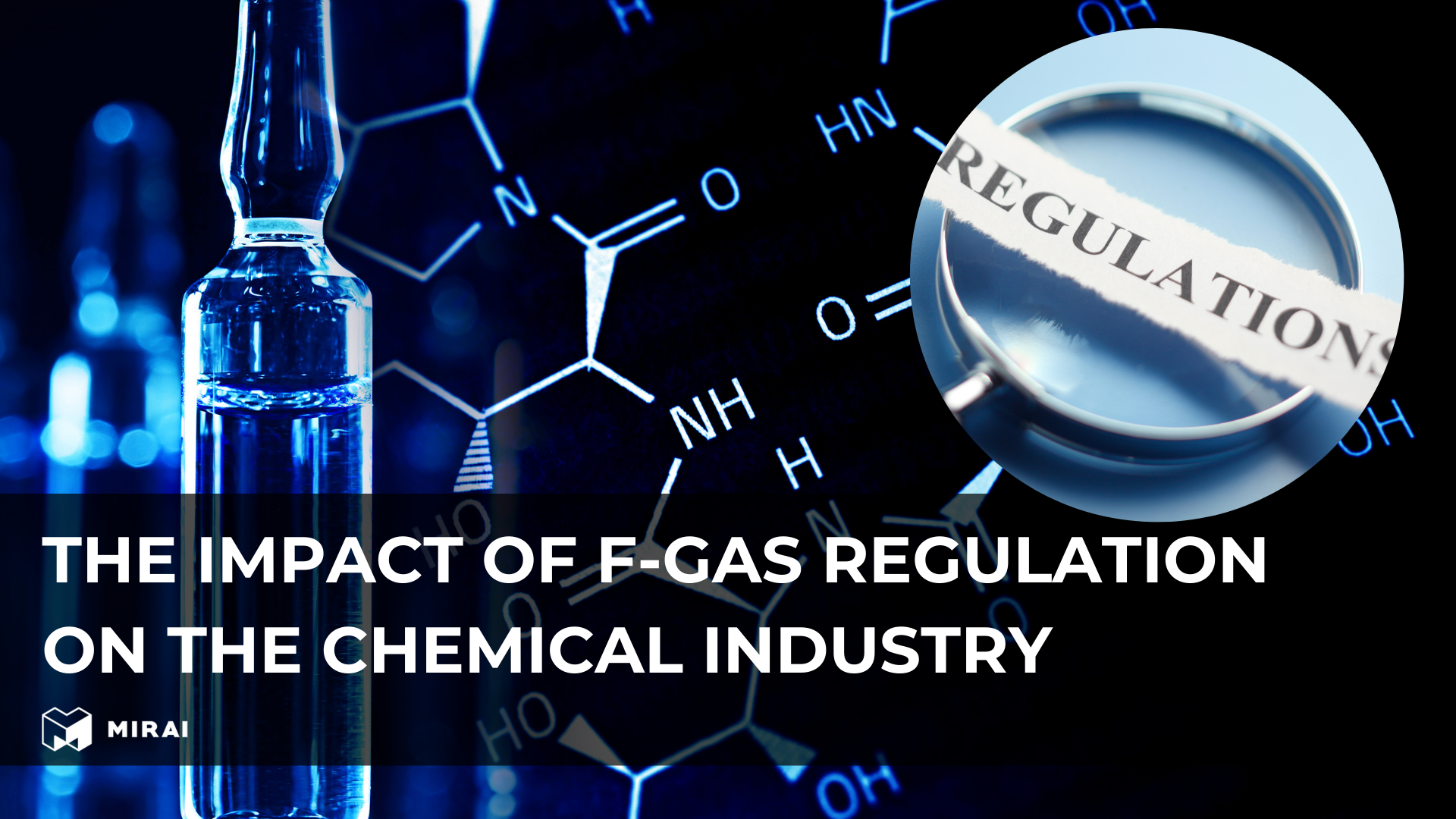F-gas regulation on the chemical industry

Fluorinated gases, or F-gases, are synthetic compounds that contain fluorine. These gases are widely used in various industrial applications, particularly as refrigerants, propellants, and insulating agents. They have unique chemical properties that make them highly effective for cooling and insulating applications. However, fluorinated gases, especially hydrofluorocarbons (HFCs), are known to have a significant environmental impact due to their role in contributing to global warming and the depletion of the ozone layer.
F-gases are potent greenhouse gases (GHGs), with a global warming potential (GWP) that can be thousands of times greater than carbon dioxide (CO2). This has led to stringent greenhouse gas regulations aimed at reducing their use and emissions. The regulatory efforts around the world, particularly in Europe, have targeted the phase-down and eventual replacement of F-gases with more sustainable alternatives.
The Role of Fluorinated Gases in the Chemical Industry
Fluorinated gases play a critical role in the chemical industry, especially in applications involving refrigeration, air conditioning, and the production of insulation foams. They are key components in the cooling systems of both residential and industrial equipment, ensuring efficient performance and preventing overheating.
In the production process, F-gases are used as refrigerants in various equipment, such as chillers and air conditioners. Their ability to provide high cooling efficiency while being chemically stable has made them the go-to choice for decades. However, the chemical industry's reliance on these gases is under increasing scrutiny due to the environmental risks they pose. As regulations tighten, the industry faces pressure to innovate and find alternatives that align with new greenhouse gas regulations.
Greenhouse Effect Problem
The greenhouse effect is a natural process that helps regulate the Earth's temperature by trapping heat from the sun. However, human activities, including the emission of greenhouse gases like fluorinated gases, have intensified this effect, leading to global warming. F-gases, due to their high GWP, trap heat more effectively than CO2, contributing significantly to climate change.
The release of these gases into the atmosphere not only exacerbates global warming but also damages the ozone layer, which protects life on Earth from harmful ultraviolet (UV) radiation. The risks associated with F-gas emissions, including extreme weather events, rising sea levels, and disruptions to ecosystems, have made the regulation of fluorinated gases a priority on both a national and global scale.
Regulation of Fluorinated Gases
Kyoto Protocol
The Kyoto Protocol, adopted in 1997, was one of the first international agreements to address climate change by setting legally binding targets for reducing GHG emissions, including fluorinated gases. Under this protocol, industrialized countries were obligated to reduce their collective GHG emissions by an average of 5% below 1990 levels during the first commitment period (2008–2012).
Fluorinated gases were specifically included in the protocol because of their high GWP. The agreement paved the way for subsequent greenhouse gas regulations, especially in Europe, where stricter measures have since been implemented.
EU Regulation No. 517/2014
Europe has been at the forefront of F-gas regulation, with the introduction of EU Regulation No. 517/2014 on fluorinated gases. This regulation aims to reduce the use and emissions of F-gases in the European Union by 79% by 2030 compared to 2015 levels. It also establishes a quota system for the import and production of F-gases, encouraging companies to find alternatives to these harmful substances.
The regulation outlines a phase-down schedule, with quotas gradually decreasing over time. It also imposes strict monitoring and certification requirements for equipment that uses F-gases, ensuring that companies comply with emission limits and take steps to minimize leaks and promote recycling. Equipment operators must have proper certification to handle these gases, ensuring their safe and efficient use while reducing the risk of environmental damage.
In the chart below you can see the latest update from 2023 on F-gas regulation
Impact of Regulation on the Chemical Industry
- Cost Increases. The introduction of F-gas regulation has led to increased costs for the chemical industry. Companies are required to comply with strict monitoring and certification standards, which often involve additional investments in leak detection equipment, training for personnel, and more frequent maintenance to ensure compliance. The quota system, which limits the amount of F-gases that can be produced or imported, has driven up prices for these gases, increasing operational costs for industries that rely on them.
- Changes in Production Processes. In response to these regulations, many chemical companies have had to rethink their production processes. This has involved adopting more sustainable technologies, switching to low-GWP refrigerants, and investing in research and development (R&D) to find alternatives. The need to comply with phase-down targets has accelerated innovation within the industry, leading to the development of new refrigerants that are less harmful to the environment while maintaining the same efficiency as traditional F-gases.
Alternatives to Fluorinated Gases
- Natural Refrigerants. Natural refrigerants, such as air, carbon dioxide (CO2), have emerged as viable alternatives to fluorinated gases. These substances have a much lower GWP compared to HFCs and are considered more environmentally friendly. For example, air and CO2 is already widely used in commercial refrigeration systems and industrial cooling applications, while ammonia is known for its high efficiency and low environmental impact. Great example of efficiency refrigeration systems that use only air are refrigeration machines from Mirai Intex. These machines are already widely used in many applications, including chemistry production. Mirai Intex also supports the Sustainable Development program.
- Synthetic Refrigerants. Some companies have developed synthetic refrigerants designed to replace F-gases. These refrigerants typically have a lower GWP than traditional F-gases, making them a more sustainable option for industries that require high-performance cooling systems. However, the challenge lies in ensuring that these synthetic alternatives meet both regulatory requirements and industry standards for efficiency and safety.
Mirai Products that Can Serve as Alternatives
Mirai Intex is committed to offering sustainable solutions for the chemical industry. Our range of products includes cutting-edge alternatives to traditional fluorinated gases, such as natural refrigerant - air, and advanced cooling systems that minimize emissions and reduce energy consumption. These products not only comply with current greenhouse gas regulations but also provide superior efficiency, helping businesses reduce their carbon footprint and contribute to the fight against climate change. It is necessary to mention that air can't be the subject of any regulation because of its 0 GWP and 0 ODP, that makes it the ideal long-term solution and helps our customers to forget about any quotas and problems with refrigerant costs and system refilling.
Development Perspectives
The future of the chemical industry lies in its ability to adapt to new environmental standards and regulations. The phase-down of F-gases presents both a challenge and an opportunity for companies to innovate and lead the way in sustainable practices. The development of new refrigerants, recycling technologies, and more efficient cooling equipment will play a critical role in the industry's evolution.
Ongoing R&D will be essential to achieving further reductions in GHG emissions. Companies will need to collaborate with regulators, researchers, and other stakeholders to develop solutions that meet both environmental goals and market demands. This collaborative approach will drive the adoption of alternative technologies, ensuring that the industry remains competitive while reducing its environmental impact.
The Role of the Chemical Industry in the Fight Against Climate Change
The chemical industry is at the forefront of the global effort to combat climate change. By reducing emissions, improving energy efficiency, and developing sustainable alternatives to fluorinated gases, the industry can play a significant role in mitigating the effects of global warming. The transition away from F-gases and toward more environmentally friendly solutions is a crucial step in achieving the broader goal of reducing GHG emissions.
Through innovation, investment in new technologies, and compliance with greenhouse gas regulations, the chemical industry can help shape a future where cooling and refrigeration systems contribute to climate solutions rather than climate problems. The success of these efforts will depend on the industry's ability to adapt to change, embrace sustainability, and drive forward the development of alternative refrigerants that align with the goals of climate and environmental protection.

